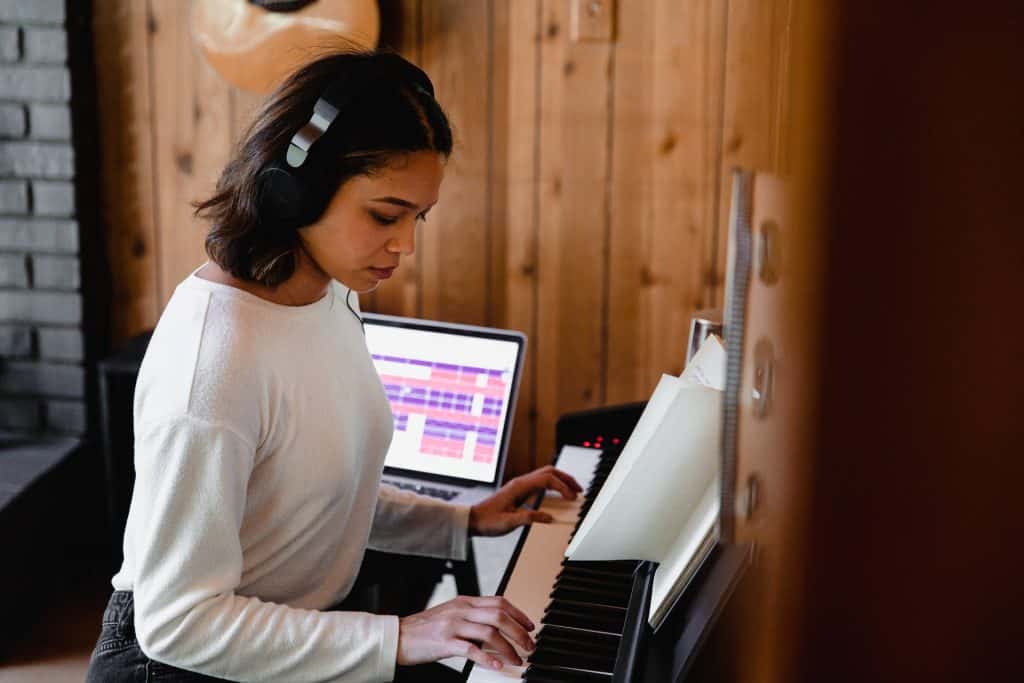Major and minor chords – nothing less than the foundation of Western music! In this article you will learn to identify them; to understand their relationship to key; to use them to enhance your interpretations; and to put them to work to develop your improvising and grow your repertoire.
A Brief History of Tonality
Tonality is the word used to describe the organization of pitches (notes) in order of importance in relation to a fundamental. The word ‘fundamental’ is not used very often beyond music theorists. However, you may be familiar with the word ‘key note’ or ‘tonic’ which means the same.
It may surprise you to know that music has not always been organized in the major-minor tonality. In Western music the tonality before 17th Century was modal. The modes have not completely disappeared, in fact they are used in some of the most well-known songs. These hits are all written in the Dorian mode.
- Eleanor Rigby – The Beetles
- Scarborough Fair – Simon & Garfunkel
- Purple Haze – Jimi Hendrix
The major – minor tonality gets its name from the major and minor scales which it is based on. However, even this familiar system has slowly been dismantled as composers from 1880s onwards have experimented with increasingly chromatic and atonal writing. For example Debussy who used the whole tone scale. 
Back to Major – Minor Tonality
In order to understand major and minor chords and how they are used in melodies it is useful to know a bit about key. Music is organized into 12 major and 12 minor keys. Each major key has a minor key that it is ‘related’ to. They are related because they consist of the same notes. For example, C major is related to A minor.
C major
C, D, E, F, G, A, B, C
A minor
A, B, C, D, E, F, G(#), A – Depending on which version of the minor scale you play, you may have a G sharp or a G natural.
Play these scales on your piano and listen to the different sounds and atmospheres created simply by starting on a different note in the sequence.
To learn more about scales, click here. Now we are moving on to creating chords out of scale notes.
Building Chords
Chords can be built on any note of the scale. They are built on skips which means that in C major scale you can build a chord of C by:
Playing C – skipping D – playing E – skipping F – playing G.


Go to your piano and play these notes, C, E, G. You have now played a C major chord. However, that is not the only chord that you can make in C major scale. By repeating the same process on every note of the scale you can also make:
- D minor
- E minor
- F major
- G major
- A minor
- B diminished
Time for some more playing, using Heal the World you can learn C major (C), D minor (Dm), and E minor (Em) chords. These are the first three chords of the C major scale. The Skoove app will listen and wait for you so take you time to appreciate the different sounds of the major and minor chords.
Two points of interest
- A three note chord is called a triad.
- A C major chord does not have to be played the in C, E, G position. As long as those notes are present, no matter the order or number notes, as long as they are C, E, G then the chord is still C major.
If you are interested in using chords to develop your piano technique read this article, What is an arpeggio and how to play it.
Identifying Major and Minor Chords
There are three ways of identifying major and minor chords.
- Recognising the tonality from the sound of the chord
- Recognising the tonality from the intervals used in the chord
- Recognising the tonality from the chord symbols on the music
Follow this link to read Six Ways Music Affects Your Emotions
Recognising the tonality from the sound of the chord
This is a very intuitive approach. The major chord is often described as brighter and the minor chord as darker. Similarly, a major key feels more optimistic and a minor key more troubled.
I have chosen one of my favourite composers and pieces to share with you. It exemplifies the power of juxtaposing major and minor. In this example you can also practice your recognition of major and minor. Schubert often uses the technique of moving from major to minor and back to major to bring a sense of pathos, tension and story telling to his music.
Listen to this Schubert Impromptu Number 2, D935. At 1 minute 30 seconds the ‘middle section’ begins. Can you hear when the tonality changes? Take note of the time in the video, I have written the answer at the end of the article.
Recognising the tonality from the intervals used in the chord
This method is grounded in theory and through simply counting the semi-tones between the notes of a chord you can work out if it is major or minor. Many people use this as a way of checking their ear has identified the tonality correctly.
💡 What you need to know
- There is only 1 different note in C major and C minor (or any major and minor chord with the same starting note)
- Major chords start with a major 3rd followed by a minor 3rd
- Minor chords start with a minor 3rd followed by a major 3rd
- A major 3rd is 4 semitones
- A minor 3rd is 3 semitones.
C Major

Starting from C, move 4 semi-tone steps and you will land on E. This shows you are looking at a major chord because a major 3rd is 4 semitones. (A semi-tone step is the smallest one you can make on the piano, in this case, C#, D, D#, E, are the 4 semi-tone steps you will take to reach E).
The last note is G, starting from E, move 3 semi-tone steps and land on G.
C Minor

Starting from C, move 3 semi-tone steps and you will land on E flat. This shows you are looking at a minor chord because a minor 3rd is 3 semitones.
The last note is G, starting from E flat, move 4 semi-tone steps and land on G.
You can use this to work out the tonality of any chord you play providing it is in root position. You know a chord is in root position when it follows the pattern:
play a note – skip a note – play a note – skip a note – play a note.
Here is a handy chart showing the notes of all 12 major and minor chords. If you want to read more about piano intervals follow this link.
Recognising the tonality from the chord symbols on the music
This method is based on understanding chord notation as it is written in a lead sheet or in pop music. These are the basics which you can build on over time.
- The letter name gives you the key note or starting note of the chord
- A lower case ‘m’ tells you the chord is minor
- If the chord is major it will simply appear as the starting note of the chord, for example, D is D major.
Let’s play some music with chord symbols. Here is King of Pop Patterns. It uses C, G, F majors and A minor. Use the hand and keyboard image on the Skoove app to make sure you are using the correct fingering. It is important in developing your hand shape.
Making Chords Work for You
How does knowing about chords support my playing? –
Chords can be used to develop your playing in many different ways.
- Use chords to develop your technique
- Use chords to grow your repertoire and learn faster
- Use chords to improve note reading through pattern recognition
- Use chords to improvise
- Use chords to enhance interpretation
- Use chords to develop your listening skills
Use chords to develop your technique
Having established that Western music is built on the major-minor tonality it is clear to see how the more familiar pianists become with major and minor chords the better they will be able to play. Chords are core stock to pianists. Practising chords will develop technique as well as chord recognition.
Use this progression from Unchained Melody to develop your technique. Keep your fingertips firm, your fingers rounded and your wrist free as you sink into and float out of these chords. The Skoove app will listen and wait for you.
Use chords to grow your repertoire
If you do not know about 4-chord songs here is a fun introduction:
Learn these 4-chords to play all those songs:
C major (I), G major (V), A minor (vi), F major (IV).
For more fun with this chord progression follow this link.
Use chords to improve note reading through pattern recognition
When you see chords in your music, use this top tip for reading them. Train your eyes to read the bottom note first and then use pattern recognition to read the other notes. It is not necessary to read and recognise the name of each note. Rather focus on identifying the interval between the notes and feeling what it is like to play.
Use chords to improvise
Improvising on a chord sequence is a great way to begin exploring the creative and fulfilling skill. This is because the framework of a powerful chord sequence holds your playing. Try it out now with this sequence in the left hand:
- C major (I) – C, E, G
- G major (V) – G, B, D
- A minor (vi) – A, C, E
- F major (IV) – F, A, C.
The right hand can pick out a melody. If you are new to this, start with long melody notes.
To further explore chords and see examples of improvisation, follow this link.
Use chords to enhance interpretation
In music, it is possible for different people to have different interpretations. How you choose to play a piece allows the listener to hear what the music means to you, that is, your interpretation. In the Schubert above the minor section increased tension. Being sensitive to the impact key and chords have on the music you play supports you in developing your interpretation.
Use chords to develop your listening skills
The more you practice listening for and identifying chords the quicker your listening skills and your ear will develop. This is vital for musicians who rely on accurate listening to develop their playing and improvising.

Love chords, want more?
I hope you have enjoyed exploring major and minor chords. I have really enjoyed sharing one of my favourite piano pieces with you. If you want to know more, check out these articles:
Look out for my future article on 7th chords to jazz up your sound.
Schubert Major – Minor Listening Challenge
Schubert Listening Practice Answer – The minor section starts at 2 minutes and 2 seconds. The major section briefly returns at 3 minutes and 8 seconds before leading us back to the opening theme.
Author of this blog post:

Roberta Wolff started piano lessons at the age of five and is still enjoying learning! Currently, she teaches piano pedagogy and performance pedagogy at post graduate level in the UK. Her other work includes running a private teaching practice for students of all ages and abilities and creating learning and practice resources. Roberta loves writing as a means to supporting others on their piano journey.
